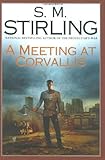Review: A Meeting at Corvallis

In Dies the Fire, the first book of the trilogy, the "Change" instantly and permanently disabled electricity, high-powered chemical reactions, and explosives, plunging mankind back into the Dark Ages. Ninety percent of the planet’s population died in the first year, mostly from disease, starvation, or murder. Dies the Fire follows several groups that form in Oregon’s Willamette valley, including the Clan Mackenzie and the Bearkillers.
The second book, The Protector’s War, took place nine years later. The tyrannical Protector of Portland and his feudal barons start to provoke war against the troublesome groups to their south.
In A Meeting at Corvallis, full war finally breaks out, pitting the free-minded Mackenzies, Bearkillers, and their neighbors against the neo-medieval Portland Protective Association.
Stirling is well-known both for alternate history and militaristic SF. Here he transplants the Dark Ages onto twentyfirst century America. Post-apocalyptic, but through no fault of our own. Some characters jokingly ascribe the mystery of the Change to Alien Space Bats for want of a better explanation.
Stirling enjoys his battles and works in plenty of them. Gunpowder doesn’t work, so they have to be fought the hard way, with swords, bows, pikes, cavalry, and catapults. For all the militarism, he has several sympathetic lesbian and gay characters, and the Clan Mackenzie are Wiccans.
A graffito on a wall in Corvallis sums it up: Help, I’ve fallen into the RenFaire and I can’t get out!